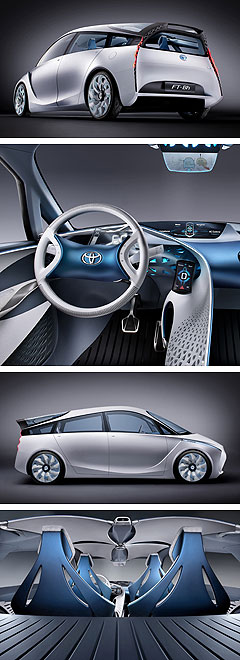Geneva show: Toyota hybrid cracks 50g/km
BY MARTON PETTENDY | 7th Mar 2012

The figures undercut similarly sized city-hatches, including Hyundai’s facelifted i20, which emits just 84g/km from a new 1.1-litre three-cylinder diesel engine, and Toyota’s own Yaris hybrid, which emits only 79g/km and also made its world debut at this week’s Geneva show before hitting European roads in May.
However, neither the i20 Blue Drive diesel nor the Yaris hybrid will be sold in Australia – where next month the new pint-size Prius C hatch is likely to eclipse the regular Prius (89g/km) as the nation’s most environmentally friendly new car – while the fuel-sipping FT-Bh is for now just a concept.
The super-efficient FT-Bh was bookended in Geneva by the FCV-R concept, which debuted at last year’s Tokyo show and previews the fuel cell vehicle future Toyota has committed to making reality by 2015 (before selling “tens of thousands” of FCVs in the 2020s), and the coupe-like NS4 hybrid sedan concept that previews the next Camry’s styling.

Now Toyota has revealed the full-hybrid FT-Bh four-seater consumes just 2.1L/100km and emits only 49g/km – the same figures achieved by the Prius Plug-In Hybrid, which offers a 25km of zero-emissions driving range and goes on sale in Europe in mid-2012 but is yet to be confirmed for Australian release.
It said the key to cutting the standard petrol Yaris’ consumption by some 50 per cent was combining a 25 per cent lower (sub-800kg) kerb weight with 30 per cent better (0.235Cd) aerodynamics and a downsized (1.0-litre twin-cylinder) petrol-electric drivetrain, without resorting to exotic materials or expensive production techniques.
Toyota claims the result is benchmark-setting (non-plugin) efficiency from a full-hybrid vehicle that is longer than a Yaris but employs economically viable technologies and is built at a cost “appropriate for a high-volume B-segment car”, giving it solid production potential.
Although Toyota continues to favour petrol-electric propulsion over diesel power – at least in its passenger car models – it said the flexibility of its Hybrid Synergy Drive system could see potential compressed natural gas hybrid and plug-in hybrid versions produce even lower carbon emissions at just 38g/km (CNG-HV) and 19g/km (PHEV).
Toyota said the ultra-light and slippery FT-Bh show car, which uses about half as much fuel (almost 135mpg in the old money) as Europe’s 1.0-litre petrol Yaris – measures 3985mm long, 1695mm wide and 1400mm tall, and rides on a 2570mm wheelbase.
Apart from reducing mass and both air and road resistance, Toyota engineers focused on powertrain efficiency, thermal energy management and electricity use by ancillary powertrain components.
Aerodynamics were optimised by maximising the car’s glass area via the use of thin roof pillars, while Toyota’s target of reducing the 1.0-litre Yaris’ 1030kg kerb weight by a quarter was achieved with the use of high-tensile steel, aluminium and magnesium, resulting in a Smart ForTwo-beating total mass of just 786kg.
Toyota said that to achieve its weight reduction target the combined mass of the bodyshell, interior trim, chassis and electronics had to be reduced by around 340kg – or one third of Yaris’s weight – because the two-cylinder hybrid powertrain is heavier than the triple-cylinder 1.0-litre Yaris engine (about 60kg).
However, it points out the FT-Bh’s new 1.0-litre Atkinson-cycle twin not only combines high efficiency with low thermal capacity and internal friction, but weighs almost 90kg less than the 1.8-litre petrol-electric drivetrain in the conventional Prius.
While the FT-Bh could preview a future light-sized Toyota hybrid beyond the Yaris hybrid, for now the Japanese giant is ramping up production of the latter by adding a third shift at its Yaris plant in France.
Hybrid vehicle sales have not met expectations in Australia, but Toyota has sold more than 400,000 petrol-electric models in Europe and expects to sell its four millionth worldwide in the next few months.